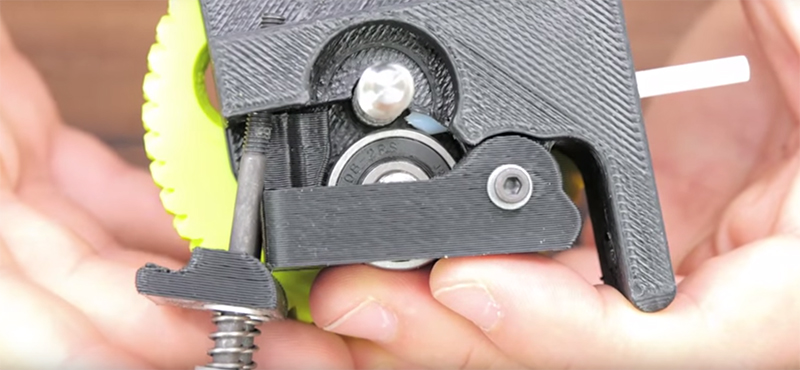A few weeks ago, I published a post discussing the filament diameters common in 3d printing. For no reason whatsoever, consumer 3D printers have settled on two different sizes of filament. Yes, there are differences, but those differences are just a function of engineering tradeoffs and historical choices. [Thomas], YouTube’s 3D printing guru, took this post as a challenge: what does it take to convert a printer to accept different sizes of filament? Not much, actually.
The printer [Thomas] is changing out to accept 1.75mm is the Lulzbot Mini, one of the most popular printers that would ever need this modification. The only required materials is a new hot end suitable for 1.75mm filament, a 4mm drill, and a few wrenches and allen keys. It would be a smart idea to get a hot end that uses the same thermistor as the old one, but that’s not a deal-breaker as the problem can be fixed in the firmware.
Disassembly was easy enough, and after mounting the PTFE tubing, cutting the old wires, soldering in the new hot end, thermistor, and fan, [Thomas] had everything set up and ready to go.
It should be noted that changing a 3mm hot end to 1.75mm doesn’t really do anything. Just about every filament is available in both sizes, although it may not be convenient to buy 3mm filament locally. It would be a good idea to change out the hot end so can standardize your workshop or hackerspace on a single diameter of filament.















1st Step: Buy a 1.75mm hotend…. no wonder it’s not hard
2nd step: ???
3rd step: SanjayM profit!
I take it you didn’t watch the video. Thomas covered properly sleeving the extruder system too. Just switching hot ends without changing the drive is simply asking for jams.
If he’s a 3D printing guru you’d think he wouldn’t show off prints where the layers are barely sticking together (left black part in the photo here).
Actually, there are advantages and disadvantages to each size.
3mm is stiffer, making it slightly easier to work with for bowden type setups and flexible materials, though flex+bowden still doesn’t work all that great.
However, the larger size gives you less control over extrusion flow, since for a given stepper motor microstep size and gear ratio, you’ll move less linear filament if the filament diameter is smaller.
Additionally, some very exotic filaments are only available in 1.75mm (FEP, PEEK, and a few others), though for most users this is not a concern.
Additionally, if you’re looking for more than 2 hotends on your printer, it’s much easier to pick an off-the-shelf solution like the E3D Kraken (4x 1.75mm), than it is to find/build a 4 nozzle 3mm hotend.
^^This
It seems to me that the 3mm filament has more linear extrusion resolution than the 1.75 because of the reduction gear normally used with the larger filament.
At the prices hotends have dropped to, no big deal, especially if your printer has one of the common ‘standard’ size/types that have been developed. If it’s from some out of business company that made their own unique design, you’re going to have to do some alteration to mount a different hotend.
How about some ‘hard core’ hotend hacking? Lathe turn and press a metal sleeve into the 3mm hotends melt zone and replace the teflon tube or install one in the cool zone to sleeve it down for the smaller filament? That’s more like what I was expecting from the headline.
I don’t see the purpose of changing. Everywhere i looked for filament everything was available in both sizes, at least here in Europe.
I do however have the curiosity of what would happen if you put 1.75mm filament in the 3mm extruder, assuming you make it thight enough to be grabbed and change the slicer settings.
He had a Lulzbot review unit that took 3mm and his existing filament collection is 1.75, that’s why for him. Ideally you buy/build based on what you already have, but at least this is an option if the machine you want isn’t in your existing size.
Thomas sleeved the extruder guide with PTFE. That might make it even more reliable, if it’s done decently.
With the all metal hot ends on LulzBots, such as Mini and TAZ 5, we have seen internally and users have posted in our forum, that they can print 1.75mm filament well, even without modification. There’s a few threads about it, such as this:
https://forum.lulzbot.com/viewtopic.php?t=1923
This kind of answers my question, thanks!